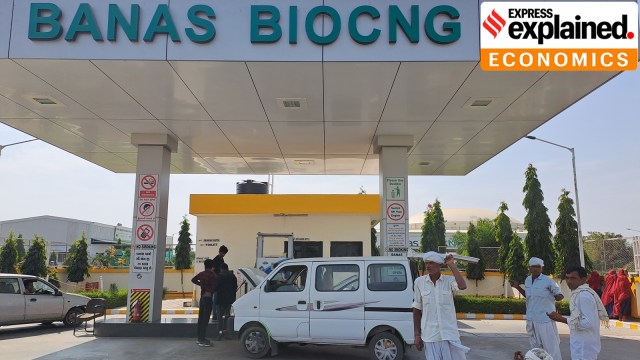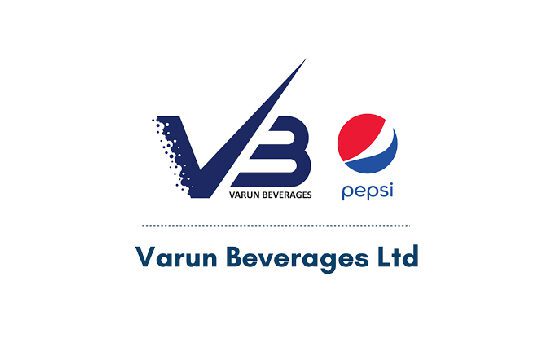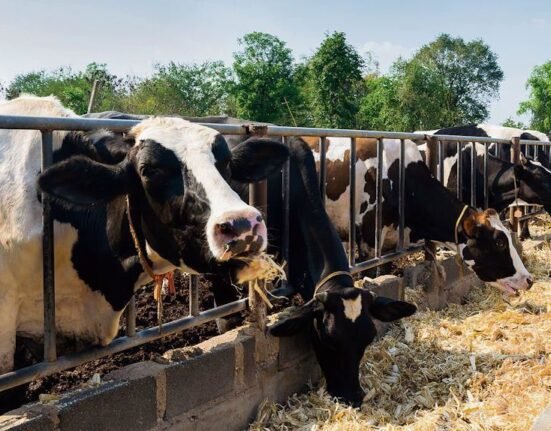From a distance, it looks like any CNG (compressed natural gas) outlet. But the one on the Deesa-Tharad highway in Gujarat’s Banaskantha district, catering to 90-100 vehicles daily, is India’s first and only gas-filling station based on dung from cattle and buffaloes. The ‘BioCNG’ outlet in Dama village of Deesa taluka, belonging to the Banaskantha District Co-operative Milk Producers’ Union, sells 550-600 kg of gas per day generated from 40 tonnes of dung at an adjoining four-acre plant.
Dung facts
An average adult bovine animal discharges 15-20 kg of fresh dung daily, while calves give out 5-10 kg. Fresh dung contains 80-85% water; one kg weighs hardly 200 grams on drying.
A biogas plant requires fresh dung, which contains methane along with water. The methane is produced by bovines inside their rumen (first of four stomach compartments), where the plant material they eat gets fermented or broken down by microorganisms before further digestion. Carbohydrate fermentation leads to production of carbon-dioxide (CO2) and hydrogen. These are used by archaea (bacteria-like microbes in the rumen) to produce methane, which the animal expels either as gas or in the dung.
The dung left to dry in the open releases both water and methane. To realise its fuel value, the dung has to, therefore, be collected and delivered in fresh form at the biogas plant. “We purchase about 40,000 kg daily from 2,700-2,800 animals of 140-150 farmers. The farmers are from five villages within 10 km of our plant,” said Priyank Mehta, Senior Executive (BioCNG) at the Banaskantha Union.
The union — India’s largest dairy concern, which procured an average 72.03 lakh kg per day (LKPD) of milk in 2022-23, including 5.74 LKPD from outside Gujarat — is paying farmers Rs 1/kg and bearing the cost of transporting the dung by five tractor-trolleys doing two trips a day.
Anaerobic digestion is a process by which the complex organic matter in dung is broken down in the absence of oxygen to produce biogas. The digestion, taking place in a 3,000 cubic-meter sealed vessel reactor, involves four successive stages: hydrolysis (break-down of organic matter into simple molecules), acidogenesis (their conversion into volatile fatty acids), acetogenesis (production of acetic acid, CO2 and hydrogen) and methanogenesis (biogas generation).
“The slurry, formed by mixing the dung with water for 2-3 hours, ensures proper hydrolysis in the digester over 35 days. From 40 tonnes of dung, we get 2,000 cubic meters of raw biogas containing 55-60% methane, 35-45% CO2, and 1-2% hydrogen sulphide (H2S) and moisture,” explained Mehta.
The raw gas is purified for removing CO2 (through vacuum pressure swing adsorption or VPSA process), H2S (using activated carbon filter) and moisture (with air dryer separator). The end-product, purified (to 96-97% methane, 2-3% CO2 and below 0.1% H2S and moisture) and compressed, is stored in cascades. This compressed biogas (CBG), conveyed through pipelines to the dispensers at the fuel station, is what’s being sold as BioCNG at Rs 72/kg.
But it isn’t just fuel
The slurry, from mixing 40,000 litres of water with 40,000 kg of dung, is a source of bio-fertiliser. This residue of 75,000-78,000 kg, coming out after anaerobic digestion and biogas production, undergoes dewatering in a solid-liquid separator.
The separated solid (6,000-8,000 kg) is decomposed in aerobic condition (presence of oxygen) for sale as PROM (phosphate-rich organic manure, incorporating rock phosphate and phosphate solubilising bacteria) or compost (after adding neem and castor cake, sugarcane press mud and microbial consortia). Out of the liquid part, 30,000-35,000 litres is re-used for mixing in the digester and the balance sold as liquid fermented organic manure.
The Banaskantha Union is currently marketing 8,000-10,000 kg of bio-fertiliser daily, with PROM (also called BioDAP, as a substitute for di-ammonium phosphate) fetching Rs 15-16/kg and compost Rs 8-10/kg. At an average realisation of Rs 12/kg, the Union’s revenues from bio-fertiliser sales are actually higher than from the 550-600 kg of BioCNG at Rs 72/kg.
The 40 tonnes-per-day dung-based BioCNG plant, functional since August 2020, cost Rs 8 crore. The Banaskantha Union plans to commission four more, with 100 tonnes capacity each, by 2025. The Rs 230 crore investment in the four plants is to come from Suzuki Motor Corporation (India’s leading car maker), with the Banaskantha Union providing the land and the National Dairy Development Board handling project execution.
“The BioCNG model is replicable and scalable, because all our district member unions can procure the required dung from their farmers, just as they do with milk,” Jayen Mehta, managing director of the Gujarat Co-operative Milk Marketing Federation, pointed out. Banaskantha district alone had 15.02 lakh buffaloes and 13.90 cattle, as per the 2019 Livestock Census. Simply put, there’s no dearth of substrate to feed the plants.
At Mujkuva village in Anand district’s Anklav taluka, Jagrutiben Padhiyar has 9 cows, 4 buffaloes and 7 heifers/calves, with 5 of the first and 2 of the second now giving milk. She grosses roughly Rs 3,500 daily by selling 80-odd litres to the village society affiliated to the Kaira District Co-operative Milk Producers Union.
But Jagrutiben has an additional revenue source, courtesy of a 2 cubic-meter Flexi Biogas plant outside her home. The sealed digester tank in the plant consumes 50 kg of dung and 50 litres of water daily. The biogas produced is delivered through a pipeline to her kitchen stove/burner, with a booster pump helping to maintain pressure.
“I stopped using LPG cylinders five years ago and don’t feel the need for Ujjwala (the Centre’s subsidised cooking gas connection scheme),” claimed Jagrutiben. Besides not spending on LPG refills, she makes money by selling 100 kg per day of slurry from the biogas plant at Rs 1/kg. The slurry is procured by a women’s bio-fertiliser cooperative in the village, Mujkuva Sakhi Khad Sahakari Mandli.
The Kaira Union has installed 750 Flexi Biogas plants in its milk shed area — 150 in Mujkuva alone — and is targeting a total of 10,000. A Flexi Biogas plant, manufactured by the Hyderabad-based SP Eco Fuel Enterprises, costs around Rs 30,000, inclusive of the pipeline, booster and burner. With a Rs 25,000 government subsidy, the payback time for the farmer is further reduced.
Whether it is the Banaskantha BioCNG plant or the Kaira Union’s less capital-intensive decentralised model, the good news is that the scope for additional income to dairy farmers from sale of dung is expanding.







